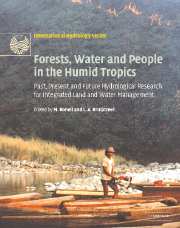 Forests, Water and People in the Humid Tropics
Forests, Water and People in the Humid Tropics Book contents
- Frontmatter
- Contents
- List of contributors
- Foreword
- Preface
- Acknowledgements
- Symposium and Workshop
- Introduction
- Part I Current trends and perspectives on people–land use–water issues
- 1 Trends and patterns of tropical land use change
- 2 The myth of efficiency through market economics: a biophysical analysis of tropical economies, especially with respect to energy, forests and water
- 3 Impacts of land cover change in the Brazilian Amazon: a resource manager's perspective
- 4 Forest people and changing tropical forestland use in tropical Asia
- 5 People in tropical forests: problem or solution?
- 6 Useful myths and intractable truths: the politics of the link between forests and water in Central America
- 7 Land use, hydrological function and economic valuation
- 8 Water resources management policy responses to land cover change in South East Asian river basins
- 9 Community-based hydrological and water quality assessments in Mindanao, Philippines
- Part II Hydrological processes in undisturbed forests
- Part III Forest disturbance, conversion and recovery
- Part IV New methods for evaluating effects of land-use change
- Part V Critical appraisals of best management practices
- Conclusion: Forests, water and people in the humid tropics: an emerging view
- Plate section
- References
8 - Water resources management policy responses to land cover change in South East Asian river basins
from Part I - Current trends and perspectives on people–land use–water issues
Published online by Cambridge University Press: 12 January 2010
- Frontmatter
- Contents
- List of contributors
- Foreword
- Preface
- Acknowledgements
- Symposium and Workshop
- Introduction
- Part I Current trends and perspectives on people–land use–water issues
- 1 Trends and patterns of tropical land use change
- 2 The myth of efficiency through market economics: a biophysical analysis of tropical economies, especially with respect to energy, forests and water
- 3 Impacts of land cover change in the Brazilian Amazon: a resource manager's perspective
- 4 Forest people and changing tropical forestland use in tropical Asia
- 5 People in tropical forests: problem or solution?
- 6 Useful myths and intractable truths: the politics of the link between forests and water in Central America
- 7 Land use, hydrological function and economic valuation
- 8 Water resources management policy responses to land cover change in South East Asian river basins
- 9 Community-based hydrological and water quality assessments in Mindanao, Philippines
- Part II Hydrological processes in undisturbed forests
- Part III Forest disturbance, conversion and recovery
- Part IV New methods for evaluating effects of land-use change
- Part V Critical appraisals of best management practices
- Conclusion: Forests, water and people in the humid tropics: an emerging view
- Plate section
- References
Summary
INTRODUCTION
Water supply is usually taken for granted in the humid tropics and perceived as stable, i.e. it is assumed that water availability will not change over a relatively long period. It is also often believed that water is an unlimited resource, hence water-related policies (if any) are seldom reviewed and adjusted. In reality water resources in the humid tropics are getting more and more depleted in terms of both quantity and quality (Bruijnzeel, 1990, 1998). The economic losses due to water shortage or excess result mainly from a lack of adjustment and responses in the public policy-making process regarding the use of resources. Water scarcity in particular and, hence, insecurity is a growing issue in areas where population pressure and rates of environmental degradation are high. Moreover, water scarcity is increasingly causing political and social tensions between upland and lowland communities and between neighbouring districts or countries or other political and administrative boundaries. Conflicts between the riparian states in the Lower Mekong Basin and within the Greater Mekong Subregion are classic examples. Controversy over the impacts of navigation and hydroelectric power projects is widespread through the region because three-quarters of the population of the Lower Mekong Basin, mainly farmers and fishermen, earn their living by utilising natural resources directly. Therefore an integrated management plan that involves the various stakeholders is necessary to avoid conflicts (Dubash et al., 2001).
- Type
- Chapter
- Information
- Forests, Water and People in the Humid TropicsPast, Present and Future Hydrological Research for Integrated Land and Water Management, pp. 121 - 133Publisher: Cambridge University PressPrint publication year: 2005
References
- 1
- Cited by


